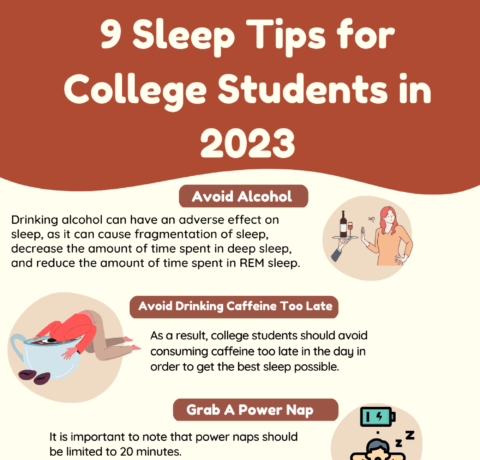How Can College Students Optimize Their Sleep Cycle
College students aren't exactly known for their healthy sleeping habits, with as many as 70% of all students reporting that they get fewer than the recommended eight hours of sleep each night. But unfortunately, these ongoing sleep deficits can lead to major problems in the classroom resulting from diminished attentiveness and concentration. So if your grades are suffering, it might not be your uber-tough professor at fault - it might be your sleep habits! The How Can College Students Optimize Their Sleep Cycle Infographic provides ideas on how to get the nightly rest you need.
Facts and stats about sleep.
- Why sleep is essential: it recharges the brain, consolidates learning, releases important hormones and repairs your cells.
- The body’s clock typically works on a 24.2 hour cycle.
- The national sleep foundation suggests that adults need 7-9 hours of sleep on average.
Problems Associated with Lack of Sleep
- 23.2% of US adults report poorer concentration
- 18.2% of US adults report forgetfulness
- 13.3% of US adults report neglecting hobbies
- 11.3% of US adults report difficulty driving
- 10.5% of US adult report neglecting financial affairs
- 8.6% of US adults report work interference
- 35% of American adults sleep fewer than 7 hours a day.
- 54% of American adults have symptoms of insomnia more than once a week.
- 25% of American adults don’t get enough sleep to be alert.
- 43.7% of 18-25 year olds in the US report falling asleep unintentionally in the daytime.
- 50-70 million Americans have a sleeping disorder.
Sleeping Aids
- 11% of adults in America use alcohol as a sleep aid
- 7% of adults in America use prescription sleeping medication
- 9% of adults in America use over-the-counter sleep aids
Sleep and the College Students
- 70% of college students sleep less than 8 hours a night.
- 68% of students have trouble falling asleep because of stress.
- 12% of students with sleep problems miss or fall asleep in class three or more times a month.
- 20% of students pull all-nighters at least once a month.
- 35% of students stay up until 3am at least once a week.
Monophasic sleep has 5 stages
- Stage 1: Lightest stage of sleep: the brain produces high amplitude theta waves.
- Stage 2: Brain produces rhythmic brain wave activity know as sleep spindles.
- Stage 3: Transition between light sleep and very deep sleep.
- Stage 4: Slow brain waves known as delta waves are produced. Very deep sleep.
- Stage 5: Dreaming occurs in this stage of sleep, also known as REM sleep. Brain and other body systems become more active but muscles further relax. 1-2 hours are spent in REM sleep each night.
Monophasic and polyphasic sleep
- Monophasic: 8 hours total sleep, within 1 block, 4 REM cycles, 33.3% of the day is spent asleep.
- Segmented Polyphasic: 7 hours of total sleep, within 2 sleep blocks, 29.2% of the day is spent asleep.
- Biphasic Polyphasic: 6.3-6.5 hours of total sleep, within 2 sleep blocks (1 core block of 5-6 hours, and 1 20-90 minute nap) - 26.4-27% of the day is spent asleep.
- Dual-core Polyphasic: 4.6-5.3 hours of total sleep, within 2-3 sleep blocks (1 core block of 2.5-3.5 hours, and 1-2 20 minute naps). 19.2-22.2% of day is spent asleep.
- Everyman Polyphasic: 2.8-5.2 hours of total sleep, within 3-6 sleep blocks (1 core block of 1.5-4.5 hours, and 2-5 20 minute naps. 11.8-21.5% of day is spent asleep.
- Dymaxion Polyphasic: 2 hours of total sleep, with 4 blocks (4 30 minute naps). Only 8.33% of day is spent asleep!
- Uberman Polyphasic: 2 hours of total sleep, with 6 blocks (6 20 minute naps). 8.33% of day is spent asleep.
Polyphasic sleep may cause poorer performance and log-term damage.
Health
- Almost 80% of Americans agree that lack of sleep causes health issues.
- 7 out of 10 Americans report that they are not getting the recommended 7.5+ hours of sleep each night.
- Sleeping less than 6 hours 4x’es your chance of getting a stroke compared to people sleeping 7+ hours.
- Sleeping less than 4 hours results in a 28% increase in ghrelin, a hormone that triggers hunger.
- Americans with 9+ hours of sleep are more likely to engage in high intensity activities.
Napping
- The best time to nap is during the afternoon (‘siesta’ time).
- Naps in the morning may be less effective.
- Naps in the evening may cause grogginess or oversleeping.
- Over 50% of American adults nap at least once a week.
Other Sleep Tips
- Stick to a regular sleep cycle
- Eat meals at set times
- Make sure you can wake up comfortably without an alarm clock - if not, go to bed earlier.
- Don’t study in bed.
- Don’t use electronics late at night.
- Avoid caffeine and alcohol before bed.
- Eat a small low-GI snack before bed.







You can adjust your cookie preferences here.